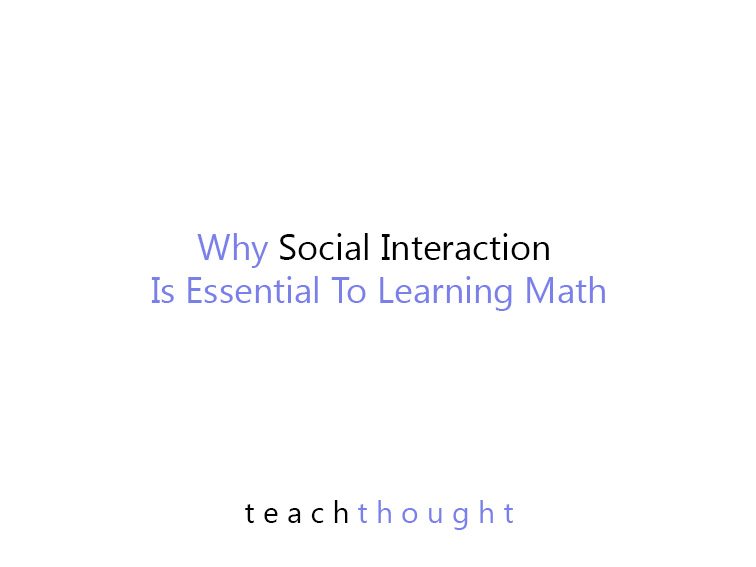
Is Social Interaction Essential To Learning Math?
contributed by Robert Sun
Not long ago, while visiting Israel, I had the opportunity to sit in on a fourth-grade class at a progressive school in that country’s North District. The young teacher that day was leading her group of 19 students as they learned English. Over the 40 minute session, as the students were introduced to 20 new English vocabulary words, speaking them aloud and using them in sentences, I suddenly realized how important active, verbal and reciprocal exchange is to learning any new language.
And math, most definitely, is a language.
I know first-hand how difficult the task of learning a new language can be because, like those Israeli students, I had to learn English as a fourth-grade immigrant from Shanghai. Speaking English day after day, my new home in Philadelphia slowly became a much more inviting place—for me, a city of promise.
Fluency in English requires the mastery of 4,000 to 5,000 new and unfamiliar words. That’s a long process. By contrast, learning math should be much easier. After all, with math you don’t have to know what a “9” means; you only need to understand how a 9 can relate to a 3 or a 27, because math focuses on relationships and how numbers connect.
One reason I believe math is challenging for so many young people, is because it is so rarely spoken. In school, math instruction focuses on the written component: the constant litany of textbooks, board work and worksheets. At best, students listen to the teacher talk about math—but rarely do they speak it at length themselves.
Each of us, from the moment we hear our parents speak our name for the first time, gained our fluency for language through verbal interaction. The constant give-and-take, as we sharpened our pronunciations and built our vocabulary, became essential in our transformation from inarticulate toddler to fully functioning adult. The process of learning math would benefit from just such a dynamic. But it’s something we’re sorely missing.
All too often we forget that language acquisition demands a verbal component. You can focus on all the writing you want, from grammar to composition to reading—but without receiving the constant interaction, feedback and encouragement from people through conversation, your progress in mastering any new language will be limited.
Developing a working vocabulary is an exercise that can take many years. Until we build a foundation of competency, we are reluctant to speak because speaking is public—and in that public act we reveal ourselves.
Our education system seeks fluency in the language of math, yet it does not encourage students to use it in a social way, producing many who are anxious about math. If they don’t have to speak math, few people really know the extent of their math proficiency. It becomes easy to keep the “secret” of how weak they may be. Like all secrets, anxiety builds the longer the secret is maintained.
Over the last several decades, in fact, being “bad at math” has become socially acceptable. Admitting you are not proficient enables you to divert the subject and protect your deficiency. Unfortunately, so many people publically make this admission that it has become a culturally accepted way to avoid getting good at math. We need to change this dynamic.
I believe that as educators and as a society, we need to develop the idea of “social math”: the use of spoken math to inspire the human interactions that provide the feedback and motivation to master fluency. We can start to develop social math by encouraging our children, from a very early age, to speak as well as write the language of mathematics.
Just as the students in that Israeli classroom learned English by speaking words out loud, we can do the same when teaching math. Teachers can encourage their students to express themselves verbally using mathematical terms; even in the early grades, children can be asked to explain what they want or mean using numbers, or relationships between numbers. Anything that encourages them to talk about math and mathematical concepts is beneficial.
5 Math Teaching Strategies That Work
Today we understand how to remove the traditional stumbling blocks that prevent many from acquiring math proficiency:
- Provide immediate feedback; i.e., social engagement.
- Offer engaging and comprehensive content at hundreds of entry points, ensuring that no matter the skill level of a child, he or she can find an entry point to experience success and move progressively to advance their skills.
- Give children a sense of control and ownership over the learning process.
- Allow students the freedom to make mistakes, so they will push their skills right to the edge. That’s where the real active learning occurs.
- Encourage our children to speak and write about math so they will be truly “math fluent.”
Technology has enabled us to develop tools that are designed to incorporate these features. Schools using these innovative tools discover that their students are eager to speak and practice mathematics.
Whenever children in a school are struggling to learn English, we invest considerably more resources into building their competence in that subject than we do when a comparable deficiency exists with math literacy. If our children are not expected to speak the language of math, they do not reveal their weakness and it becomes easier to ignore.
On the other hand, when we speak the common language of math with vibrancy and passion, we inspire our children to explore and pursue the rich opportunities offered in this essential and universal form of communication. This will benefit our next generation of thinkers immensely, providing them with the foundation to support careers in the STEM professions and every part of life.
ROBERT SUN is the CEO of Suntex International and inventor of First In Math, an online program designed for deep practice in mathematics; Why Social Interaction Is Essential To Learning Math
